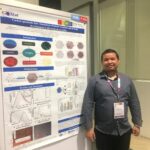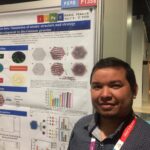Aluno do PGQUIM participa do 47º Congresso Mundial de Química em Paris
Data da publicação: 11 de julho de 2019 Categoria: NOTÍCIASNosso aluno de doutorado, Antônio Alvernes Carneiro Cruz, orientando do Professor Pierre Fechine, está participando do 47º Congresso Mundial de Química, evento que integra as comemorações do 100º Aniversário da IUPAC, que ocorre entre os dias 5 e 12 de julho de 2019, tendo como palco o Palácio dos Congressos localizado na capital francesa – Paris.
Resumo do trabalho apresentado no evento
Carbon quantum dots: Simulation of atomic structure and strategy development to discriminate proteins
Fluorescent-based sensors have attracted attention for routine analysis mainly due to their simplicity, chemical stability and handling. Moreover, sample analysis can be performed at any location and the result might be visualized by naked eye. In this regard, this work, reports a theoretical and experimental study, as well as a cheap and effective ‘chemical-nose’ strategy based on Carbon Quantum Dots (CQDs) and metallic cations (M) to discriminate proteins at concentration of 50 nmol/L. Firstly, CQDs were easily synthesized using citric acid thermolysis and further characterized by UV-Vis absorption, fluorescence, infrared (FTIR), XPS and Raman spectroscopies and by atomic force microscopy (AFM). The obtained results indicated quasi-spherical CQDs with diameters in the range of 1.2-2.8 nm, presence of stacked graphitic layers and oxygenated functional groups, as well as disordered carbon. Herein, based on the structural and morphological features, computational simulations were perfomed to obtain a better understanding of the CQDs atomic structure, as show in Fig.1. Our results evidenced a carbon-based nanoparticle formed by stacked graphene nanoflakes containing defects, being related to the presence of functional groups within graphene layers. Furthermore, a ‘nose’-based approach was developed by using three distinct CQDs – M (M = Fe3+, Cu2+ or Ni2+) ensembles, which allowed to acquire different and reproducible fluorescence patterns for four proteins (bovine serum albumin, hemoglobin, myoglobin and cytochrome C) at 50 nmol/L. Subsequently, the pattern recognition was performed using linear discriminant analysis (LDA) and 36 samples were correctly identified affording 100 % of accuracy.





